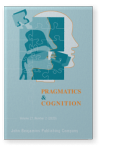Vol. 27:2 (2020) ► pp.432–456
An overview of the Japanese copula da as an utterance-final expression in conversation
The present study examines cases of the Japanese copula da used in the utterance-final position in naturally occurring conversations. The morpheme da in Japanese is typically categorized as a type of copula in linguistic studies, but da also functions as an utterance-final expression, especially in the spoken form of Japanese. The examined recordings of naturally occurring conversations for the present study contained 120 cases of utterance-final da, and 89 (74.2%) of them were uttered immediately following statements of subjective evaluation. In addition, of these 89 cases of utterance-final da that followed statements of evaluation, 87 were determined to follow statements in which the speaker expressed his or her negative attitude toward the evaluated matter. The data analysis also showed that 26 cases (21.7%) of utterance-final da in the examined recordings were uttered immediately after the speaker discovered a new piece of information. Based on the findings from the data analysis, the present study argues that utterance-final da is considered to be one of the expressions in Japanese that can signal both discovery of new information and the speaker’s negative attitude toward a stated matter. In addition, the present study also argues that da marks the speaker’s emotional exclamatory reaction when it is used in the utterance-final position.
Article outline
- 1.Introduction
- 2.Japanese da as copula
- 3.Remaining issues
- 4.Research design
- 5.Data analysis
- 5.1Cases of utterance-final da directly following statements of evaluation
- 5.1.1Utterance-final da that follows iya
- 5.1.2Statements of evaluation with other expressions
- 5.2Utterance-final da in statements of discovery
- 5.3Emotional reactions behind the use of utterance-final da
- 5.4Uncategorized cases
- 5.1Cases of utterance-final da directly following statements of evaluation
- 6.Conclusion
- Notes
-
References
